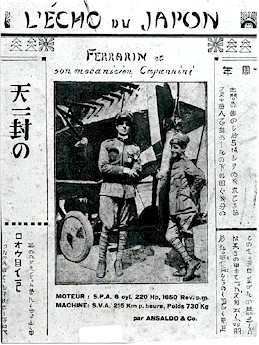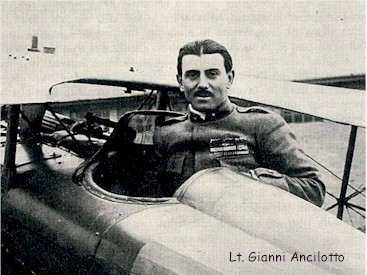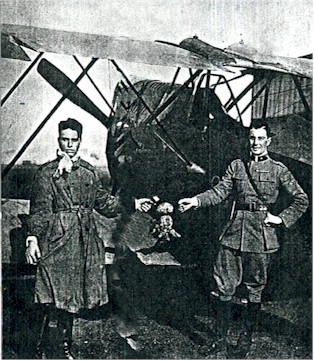(the Goodwill Tours)
By the war's end an average of 135 planes per week were rolling out of Italian plants |
 From
minor auxiliary of one hundred pilots and eighty functional aircraft in
1915, Italy’s military air service had expanded enormously over the course
of the First World War. By the close of that conflict, some 78,600
men were attached to the air arm, with about 4,000 front line aircraft
and another 2,000 on reserve. The Italian War Ministry was operating
23 technical training centers and 30 flying schools from which a thousand
pilot's brevets were being issued per month. From
minor auxiliary of one hundred pilots and eighty functional aircraft in
1915, Italy’s military air service had expanded enormously over the course
of the First World War. By the close of that conflict, some 78,600
men were attached to the air arm, with about 4,000 front line aircraft
and another 2,000 on reserve. The Italian War Ministry was operating
23 technical training centers and 30 flying schools from which a thousand
pilot's brevets were being issued per month.
The growth of the Italian Kingdom's aircraft industry was equally rapid. Total production in 1915 dwelled around the average of 30 aircraft per month, nearly all of them foreign designs built under license. By the war's end an average of 135 planes per week were rolling out of Italian plants, and over 200,000 workers had aviation-related jobs. Firms originally founded in other fields, like the automobile maker FIAT and the shipbuilders Ansaldo and Piaggio, now had thriving aeronautical divisions in their corporate frameworks. |
||
|
But what had once been a powerful and indispensable component in the struggle for victory suddenly became an obtrusive, white elephant as soon as the Armistice was signed. With Italy’s war-weary populace clamoring for immediate demobilization, and the Kingdom's ledgers deeply in the red, the massive, war-based aeronautical apparatus clearly had to go. Yet even this disposition was uncertain. In a seven month period, custody over its fate made the rounds through a bureaucratic maze, tossed like a hot potato from the War Ministry to the Ministry of the Treasury, then Industry and Commerce, then Transportation and back again. In the meantime, sweeping budget cuts left thousands of airplanes to rot and rust in dank, cobweb-covered hangars until the government ordered them to be sold, given away or destroyed outright. |
|||
| ...began a search for foreign markets to unload their surplus machines. |
Those visionaries who had hoped to see the momentum of wartime aeronautical progress continue unbroken into the post-Armistice years toward the development of a healthy civil aviation industry were cruelly disappointed. Abrupt contract cancellations proved devastating for the private manufacturing sector. The stronger companies, like Caproni and FIAT, survived the blow by negotiating partial settlements on orders in process. But many of the smaller firms, the affiliates and budding satellite industries, simply vanished as quickly as they had appeared; the resultant layoffs adding another, enormous complication to the Kingdom's uncertain transition to a peacetime economy. Facing a mutually bleak future at home, the military air service and the private industries began a cooperative search for foreign markets to unload their surplus machines. Their strategy involved sending planes piloted by army personnel on goodwill visits to foreign countries, preferably those with few or no aeronautical industries of their own, which were naturally seen as potential customers for Italian equipment. |
||
| these flights were generally designed to be of an impressive nature |
Aside from economic motives, these flights were generally designed to be of an impressive nature in the interests of national prestige, as well as with the intention of regenerating popular enthusiasm and ultimately the revitalization of aeronautical interest in Italy itself. Since the requirements seldom exceeded the simple combination of a good pilot (virtually always wartime veterans), a reliable plane and arrangements for periodic refueling, these post-Armistice demonstration flights were relatively inexpensive to stage. Leading the program was Lt. Francesco Brack-Papa, the army's top test pilot, who made the first non-stop flight between two European capitals on July 14, 1919, with his 745 mile flight from Rome to Paris in a FIAT BR series biplane. From Paris, he flew on to London in record time and then to Amsterdam, where his plane was displayed at an international exposition. |
||

Clic to enlarge... |
On September 11, Lt. Gianni Ancilotto, a 23-year-old wartime ace, conducted a non-stop flight from Rome to Warsaw, and was personally greeted upon his arrival by On Polish Prime Minister Ignace Padrewski. Lt. Ancilotto's six-hour trek ultimately resulted in the sale of 75 Ansaldo biplanes to the young Polish air force. Lt.s Umberto Maddalena and Manfredi Gravina toured Scandinavia in a Savoia S-9 flying boat a few weeks later, touching down at Copenhagen, Kristiana (Oslo), Stockholm, Helsinki and Riga. The S-9 was the first Italian aircraft to arrive in any of these countries, and it's stout performance in the region's harsh weather brought sales contracts from Sweden and Norway. Similar missions to Spain and Turkey, and the achievement of several, important aeronautical milestones in South America brought a payback in prestige as well as purchase orders. Particularly notable was the first, round trip flight over the Andes, conducted by Lt. Antonio Locatelli with an Ansaldo SVA biplane. In 1920, at the urging of the famous soldier-poet and war hero Gabrielle D’Annunzio, the air service launched the most dramatic of these post-war demonstrations by sending a group of planes on a marathon flight to Tokyo! Hostile climates and mechanical difficulties take a cruel, sometimes fatal toll on the venture, and most of the participants drop out along the way. But two of the aviators, Lt.s Arturo Ferrarin and Guido Masiero indeed managed to complete the grueling, 11,000-mile trek. A quarter of a million Japanese were on hand to greet, shouting "Italia Banzai!" as the exhausted but triumphant pilots touched down at Tokyo’s Yoyogi Park. |
